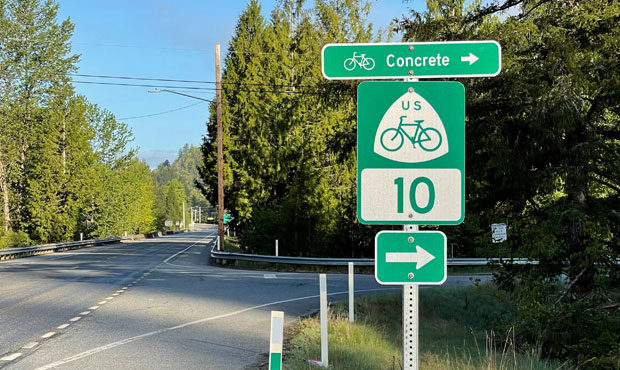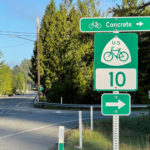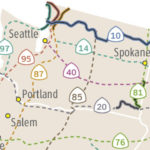All Over The Map: Pedal through history on Washington’s US Bike Routes
Aug 20, 2021, 6:35 AM | Updated: Aug 24, 2021, 10:23 am
If you’ve driven through the Skagit Valley lately along the North Cascades Highway, you might have noticed some new signage along the side of the road. Each is roughly two feet high and a foot wide and mounted on a tall post. The sign displays a white shield with “US” and the outline of a bike shape in green, along with the number “10” inside of a rectangle with tapered corners.
The signs were installed over the past year, and are for something called “US Bike Route 10,” or USBR10 for short. The bike route, and the signage along the highway, are part of a nationwide program that goes back almost 40 years, but that took until a decade ago to really get going. The organizer for the revamped national effort is a nonprofit group based in Montana called the Adventure Cycling Association.
The idea is to designate, with their own numbering system – separate from the 1920s numbering system that gave us Highway 99 through Seattle, and separate from the 1950s interstate numbering system that gave us I-5 and I-90 – a national web of bike-friendly roadways stretching from coast to coast and border to border.
Organizers say that designated routes help bicyclists find the safest places to travel, and help direct some part of the billions of dollars spent by bicycle tourists each year to communities that might be somewhat off the main highway and away from motor vehicle traffic. The routes, and especially the signage, also give motorists an alert to be on the lookout for bikes.
John Pope of Anacortes became the volunteer statewide US Bike Route coordinator for Washington in 2008. In this role, Pope works closely with the Washington State Department of Transportation and local jurisdictions throughout the state, and functions as something of a goodwill ambassador for the program.
Earlier this week, Pope told KIRO Radio that there are about 750 miles of US Bike Routes already identified in Washington. Along with US Bike Route 10 – which was first designated in 2014 – there are currently eight more numbered routes in the Evergreen State.
“Part of what the US Bike Route does is it tries to get you from Point A to Point B, but it doesn’t always get you there on the most traveled road,” Pope said. “In fact, we’re usually looking for the least traveled roads, the nice byways, and whenever we can get off, say, Highway 20, when it’s running 10,000 vehicle visits a day, the better.”
The goal, says Pope, is “to stay away from high traffic, and make the experience safe and enjoyable, and a little more ‘country.’”
Along with the “country,” there’s also quite a bit of history out there on the US Bike Routes, and the seat of a bike is one of the best places from which to get a terrific view.
Along Highway 20, for instance, much of US Bike Route 10 follows the current path of Highway 20 – which is part of what’s known as the Adventure Cycling Northern Tier route, and which includes several miles that cut through and along the boundary of North Cascades National Park. However, wherever possible, US Bike Route 10 peels off from the modern highway to instead cover ground on old and quieter stretches of vintage backroads.
In the Skagit Valley, this includes the Lyman-Hamilton Road, which is a remnant of what was called PSH-16 (the old abbreviation for “Primary State Highway 16”) in the 1950s and 1960s, and known as State 17-A before that. The old road is much closer to the Skagit River than the current Highway 20. It’s also curvier and more winding, and travels past old farms and through the 19th century Skagit River towns of Lyman and Hamilton – where cyclists share the road with far fewer cars and trucks than they do on modern Highway 20.
There are several stretches of old roadway like this in the Skagit Valley where bikes are now directed to travel. Farther east, US Bike Route 10 follows the path of Highway 20 up and over Washington Pass, but also just brushes the westernmost reaches of what was once known as the Cascade Wagon Road near Cascade Pass.
Backroads like these can offer some tantalizing sights, says John Pope.
“I’ve seen old Edsels for sale for $600 in Hamilton,” Pope said. “The car was parked there forever, and for sale forever, and somebody finally picked it up.”
“I still kick myself for not buying it,” he added, lamenting on having missed out on owning a specimen of the doomed classic.
Design-wise, the US Bike Route sign couldn’t be more different from an Edsel; it’s simple and straightforward, and easy to read. The look and feel is official and timeless, and the reflective metal signs should last for many years.
“It is kind of cool because it’s got that triangle look that you see on the Pacific Coast Trail signage and on the Pacific Northwest Scenic Trail,” Pope said. “So you kind of have the idea that you’re kind of out there a little bit pioneering, and you’re out there on a route that’s really like a ‘Blue Highway,’ and you’re much more likely to have a good time, and have services and less traffic.”
In general, US Bike Routes follow paved roadways or converted rail-trails, but road and trail maintenance and other aspects of route conditions are not something Washington coordinator John Pope has any control over.
“We can’t promise anything about the roadway,” Pope said. “We simply work with the communities who nominate their best roadways, and it’s really up to the jurisdictions to approve it.”
But, Pope says, the vetting process is rigorous.
“There is a lot of approval required before you make it to become a US Bike Route,” he noted.
Pope says that there has not yet been a concentrated effort along all the routes in Washington to install signage – that, too, is up to the individual jurisdictions through which each route travels – but each route is fully mapped out and the maps are available as PDFs.
Routes are also accessible via some apps – such as Ride With GPS – which offer users turn-by-turn instructions. Even with all the smartphone options, Pope says printed maps are critical for cyclists, especially in the rural and sometime mountainous areas that many US Bike Routes traverse.
Downloadable PDF maps are available via the Washington State Department of Transportation US Bike Route website. Current US Bike Routes in Washington include the following numbered roadways/trails, some of which overlap:
- 10 – Anacortes to Newport
- 20 – Clarkston to west of Dayton
- 281 – Idaho border to Pullman
- 40 – Idaho border to Tekoa
- 610 – Sedro Woolley bypass
- 81 – Asotin to north of Tekoa
- 87 – South Snohomish County to Sumas
- 95 – South Snohomish County to Blaine
- 97 – Coupeville to Blaine
As for how the numbers are chosen for US Bike Routes, Pope says it’s usually pretty straightforward.
“The way the numbering system works, it’s like most of the other Interstate systems, or the old federal highway systems,” he described. “The even numbers are always [for routes that run] east-west, and odds are always [for routes that run] north-south.”
For US Bike Routes in the Lower 48, numbers for east-west routes increase from north to south; numbers for north-south routes increase from east to west.
Pope says this numbering practice is something of a “tradition” from an organization called the American Association of State Highway and Transportation Officials and which is known in the industry as “ASHHTO” (pronounced “ASH-toe”).
Another tradition, it seems, is the coveting of desirable numbers for highways or, in this case, bike routes.
“We as a state are incredibly lucky because some of the most important [routes] are the ones that end in a zero,” Pope said. “We’ve got US Bike Route 10, we’ve always had US Bike Route 20, which is on the border between ourselves and Oregon, and that’s pretty cool.”
“And then 40 kind of wound around because of the rail-trail affiliation,” he continued. “[US Bike Route] 40 goes from Washington, D.C., eventually all the way to La Push” on the Washington coast.
US Bike Route 40, says Pope, will ultimately include the Palouse-to-Cascades Trail – with crossings at the Beverly Bridge and the Renslow Trestle – as well as the Olympic Discovery Trail.
Nationwide, current plans call for identification and designation of a total of about 50,000 miles of US Bike Routes.
However, there appears to be no plans in the works by any organization anywhere to designate special routes for Edsels.
You can hear Feliks every Wednesday and Friday morning on Seattle’s Morning News, read more from him here, and subscribe to The Resident Historian Podcast here. If you have a story idea, please email Feliks here.

















